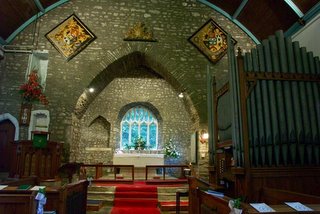 A student friend, that attends a local Baptist college, came into my office the other day in dismay over a lecture concerning the placement of the pulpit in many liturgical (or high) churches. The professor had noted the emphasis that was placed on the Eucharist (or Communion) during the Middle Ages and the removal of the pulpit to the side. The professor deduced that the placement of the pulpit to the side was an external sign of a belief that placed communion at the center of worship and preaching as subordinate or secondary to it.
A student friend, that attends a local Baptist college, came into my office the other day in dismay over a lecture concerning the placement of the pulpit in many liturgical (or high) churches. The professor had noted the emphasis that was placed on the Eucharist (or Communion) during the Middle Ages and the removal of the pulpit to the side. The professor deduced that the placement of the pulpit to the side was an external sign of a belief that placed communion at the center of worship and preaching as subordinate or secondary to it.Truly many sacramental denominations do refer to communion as the "most blessed" sacrament and believe that it is the focus or climax of true worship. The implication from the Baptist professor was that this emphasis was wrong, and that preaching should take the place as the center of true worship and the only means of grace being dispensed. Therefore the pulpit takes center stage in most protestant churches.
The issue that troubled my young friend was the ramifications of such an observation if it were applied to most Baptist churches today. To begin with the typical exterior of most Baptist churches is a plain brick rectangle with a steeple - this speaks of a practicality and modesty that is sadly disappearing. The sanctuary is situated much like a theatre with rows of pews facing a stage (I understand this is a practical and traditional way of building that is common to most churches) and communicates to the adherent a sense of observation rather than participation. The altar table (or Lord's Supper table) is generally in the lowest center of the stage in most Baptist churches. Often the altar table holds an arrangement of flowers (since it is only used for Communion four times per year) and the flowers resemble those one would place on a grave or memorial (which is very much in keeping with the Baptist view that Communion is ONLY a memorial and symbolic act of obedience). Above the table the heavy wooden pulpit is exalted which not only serves a practical purpose, but send a clear message of the importance of the sermon (the new plastic pulpits irritate me and I am not sure of the message they send). Interestingly enough the choir is raised above the pulpit, but it is located behind the pulpit which communicates the importance of "worship" (which means singing in most Baptist churches) and its secondary place of support of the sermon. On either side of the choir you will find an American flag and the "Christian flag" -- this conveys the syncretistic beliefs of many Baptists and the belief that God's kingdom IS of this world. However, the most highly exalted place in the typical Baptist sanctuary is the baptistry -- what are we to understand from this symbolic placement? Using the logic and observations of the Baptist professor we could deduce that baptism is the most important aspect of Baptist life and in essence is the "most blessed sacrament" for the non-sacramental Baptists.
I love the Orthodox and their view that the church building (and indeed the entire service of worship) should convey Heaven to Earth. Much of the art and architecture sends a message of God's holiness and the Gospel message. The crucifixion often takes center stage, the ceilings reach to the heavens, saints remind us of faithfulness and incense give the aroma of otherworldliness. There is a sense of antiquity and presence in most Orthodox churches. There can also be found an inordinate adoration of the saints and the Virgin Mary, but this, too, communicates to the adherent the reality of the communion (or fellowship) of saints.
In my book the Episcopal Church takes the prize for protestant architecture. They generally have the most beautiful, oldest and traditional buildings in town. They are saying that they are ancient, they are here to stay, and they are concerned with beauty. Furthermore, Episcopal bell towers usually have REAL bells in them (please do not even get me started on fiberglass steeples with PA systems that play fake bells)!
At Christ Community Church we have inherited a beautiful sanctuary with a typical seating arrangement of pews. Stained glass windows along the wall depict various aspects of Trinitarian belief without attempting to depict the persons of the Trinity. The windows are merely symbolic and no attempt is made to depict the body of Jesus and are therefore not to be considered graven images. We are not opposed to printed or painted images or depictions of Christ as many icons can be found on our printed materials, but you would be hard pressed to call a bulletin cover an idol. Care is taken to appeal to the sense of sight while at the same time not allowing the worshiper to fixate on an image, but rather on Christ Himself who transcends our creativity, imagination and comprehension.
There are two works of art on the wall that are passages of scripture written in a Celtic style. These passages are theme verses from past years that speak of knowing Christ and who we are in Him.
The altar table is centrally located on the floor and flanked by kneeling benches. A Bible is placed in the center of the table with bread and wine on either side of the Bible. Hopefully this communicates the importance that is placed on the written word of God and the physical body of Christ who is the Word of God.
A single goblet is filled with red grape juice and a platter holds a single loaf of unleavened bread. The single cup and loaf are symbolic of the unity we share in Christ. (However, we currently serve the juice in individual cups -- it is a practice that is practical and in consideration of germs since real wine is not being used. I do not wish to critique our practice at this time as we are in the thoughtful process of change.) Communion is taken in a kneeling position at the end of the service and in response to the sermon. Communion (or the Eucharist), then, is the "altar call" issued to believers to respond to the liturgy, scripture reading, singing and preaching of Christ. It is more than memorial or merely a symbol; it is a proclamation of our faith in Him.
Two candle stands hold a total of six candles that are lit at the beginning of each service. Two represents "witness." Three is the number of the "Trinity". Six is the number for "man". Jesus is the "Light of the world". He says that we are the "light." At CCC, we are human witnesses of the Trinity that show forth light to the world.
Our pulpit is a simple wooden podium that is moved to the center floor for preaching and removed after the sermon. The wooden podium is symbolic of the cross, and it conveys a heaviness that plastic cannot. It is movable for practical reasons, but its placement on the floor with the congregation conveys the idea that the Word of God came to dwell with us and is preached among the people.
As we occupy a former Methodist church we have no baptistry. Therefore, our baptisms must take place outside of the confines of our four walls. This forces us to take the proclamation of the Gospel to an outdoor facility such as a pool. Unwittingly, we have been placed in the position of proclaiming the death, burial and resurrection of Christ both inside and outside of the church building. We are a congregation that proclaims Christ in our regular sacred gathering places, as well as our secular community.
The musicians are placed on the raised floor that is behind the altar table and at the foot of a stained glass window that depicts the cross. On the cross hang a crown of thorns and a wreath of laurel (symbolic of the crown of glory Christ gained through His suffering). While the slight elevation difference of the platform (or stage) is due to previous design and the placement is practical for instruments, I think it does convey a slightly misleading message that we place a higher emphasis on music. At CCC I think it would be true to say that we value each element of the worship service equally. All of the service is to be Christ exalting, and conducted at the foot of the Cross to the glory of God.




.jpg)
1 comment:
Wow, Patrick, that's a great assessment of our arrangement at CCC. I must admit I hadn't thought about it that thoroughly before. One thing I have noticed is that our bulding is laid out in the general shape of the cross--the way the hallways are laid out with the rooms to the side and the sanctuary at the head of the cross layout. It's my understanding that a lot of Cathedrals were also build laid out in an architecture based on the cross.
Post a Comment